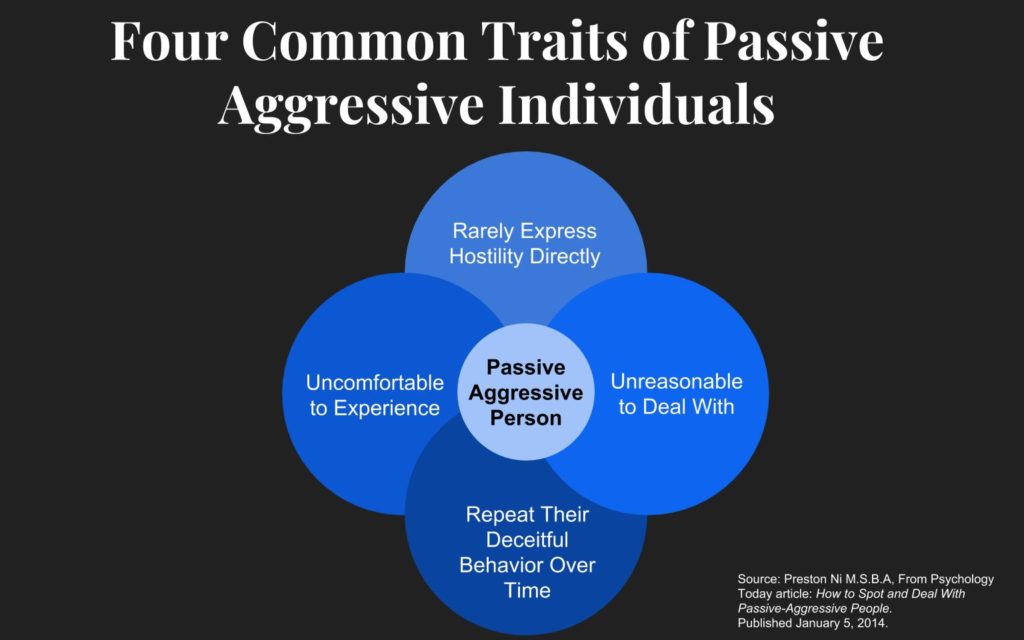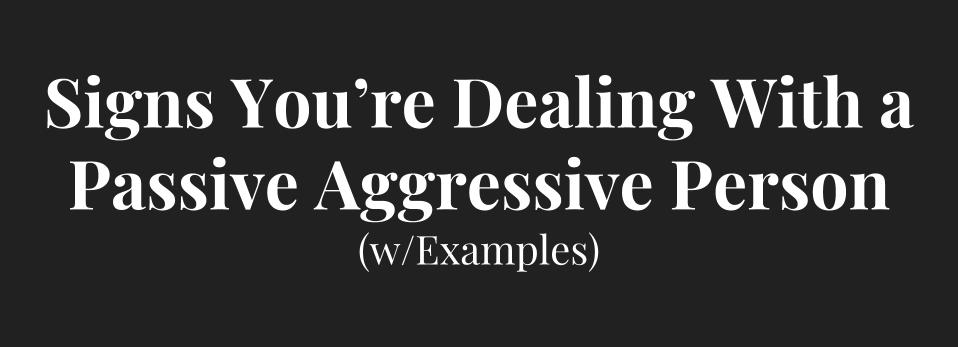
15 Signs You’re Dealing w/a Passive Aggressive Person [w/Examples] & How to Deal.
by Chris Getman | Nov 13, 2018
We’ve all been there.
Your spouse gives you the silent
treatment. Your coworker leaves you hanging on a project so you look
bad. The deflective of response “you’re being too sensitive, I was just
kidding.” But they weren’t, you know they weren’t.
Passive aggressive behavior can
actually take on some surprising forms. This post will explore the
various forms passive aggression can take so you can have a better idea
of what you’re dealing with and how to deal with it.
This post has four sections:
- What is Passive Aggression?
- The 15 Signs of Passive Aggressive People
- The Causes Passive Aggressive Behavior
- How to Deal with Passive Aggressive People
What is Passive Aggression?
The term passive aggressive
originated in the American military to describe soldiers who did not
comply with superiors’ commands. It is now more specifically defined as:
“…a
pattern of indirectly expressing negative feelings instead of openly
addressing them. There’s a disconnect between what a passive-aggressive
person says and what he or she does.” – Mayo Clinic

Source:
Preston Ni M.S.B.A, From Psychology Today article: How to Spot and Deal
With Passive-Aggressive People. Published January 5, 2014.
Source link
15 Signs You’re Dealing with a Passive Aggressive Person (w/Examples of Each)

Here’s a full list of 15 signs that you’re dealing with a passive aggressive person:
#1. They Make Backhanded Compliments
Backhanded compliments oftentimes are
the intersection of passive aggression and jealousy. Sometimes known as
“non-compliments” or “disguised insults” these statements are actually
subtle insults intended to ultimately put down the person being
addressed, without seeming directly mean spirited.
Passive aggressive examples of backhanded compliments
- If a friends buys a new house, the passive aggressive may say “It’s a nice starter home.”
- You buy a new car and the passive aggressive says “That’s a great car, it’s almost as nice as John’s.”
- “I love your new dress, I wish I had one like that but I think I’m too skinny for that style.”
- Insulting
gifts — getting someone a subscription to Weight Watchers for a birthday
present when they aren’t trying to lose weight.
These sorts of non-compliments
generally take a moment to sink in, where you might think “Thanks … oh,
wait a minute…”, and then it’s awkward to confront the person, so you
let it slide.
#2. They Make Wistful Comments
A common type of passive aggressive
behavior comes from not asking for things directly, while also putting
down the person they’re talking to, at the same time.
Passive aggressive example of wistful comments:
- “I wish I could afford a new car like yours, but unfortunately all my money goes to my student loans.”
In a twist on the above scenario,
sometimes these wistful comments may not be in response to anything, but
instead are made as a declaration quickly followed by a defeated
conclusion, such as: “I wish you would clean up the house, but I know
you’re busy and that’s not going to happen.”
In this scenario, their goal is to
announce their wish, then disown it in order to put the responsibility
on someone else. The shift in responsibility in order to spur action is a
form of manipulation. In their book Overcoming Passive Aggression Tim Murphy, PhD, and Loriann Hoff Oberlin state that:
“Passive aggressive people possess
keen skills: manipulation tops the list. They can have handy alibis and
display cunning charm. Ignorant of what’s truly happening, others grant
free passes to this behavior until they catch on and challenge or hold
the person accountable. Teachers, bosses, doctors, judges, coworkers,
even loved ones essentially give passive aggressors the benefit of the
doubt. Not until they slip up, forget to cover their tracks, or simply
accrue too much reasonable doubt are they taken to task. They can
redirect their contempt no further. Never wishing to fall from others’
graces, they offer further explanation to keep socially masking their
true intent with ‘You should have told me’ ‘I can’t get over how
sensitive you’ve become.’”
#3. They Play the Victim
In these situations, the passive
aggressor will pretend to be hurt by something innocuous another person
did, or by a situation in general. This is generally an exaggeration of a
smaller personal or health issue.
According to Preston Ni, M.S.B.A.:
“Here, the passive-aggression is
manipulation and exploitation of the partner’s good will, guilty
conscience, sense of duty and obligation, or protective and nurturing
instinct, in order to extract unreasonable benefits and concessions.”
To make this situation more
confusing, it’s uncommon for passive aggressives to speak openly and
honestly about their actual feelings. They are generally not able to
express their actual feelings in an open and healthy way.
Examples:
- Saying “you’re the only one who can help me”
- Quickly
deciding to cut someone out of their lives when it’s not necessary, just
to make the claim they “need to do this” based on an exaggerated claim.
Want to read up on how to deal with manipulative people? Give this a read. Or do you just need a distraction from a stressful situation? Then give this a read instead.
#4. They Procrastinate (Spitefully) or Fail to Finish Tasks
One passive way to express aggression
toward someone is to procrastinate on a task/project that they care
about. This accomplishes two things, it lets the other person know they
are angry, and it quite possibly makes the other person look bad (if the
delay hurts them professionally, or in some other way)
“We have found some links with
chronic procrastination and personality challenges like ADHD,
passive-aggressive tendencies, revenge, obsessive-compulsive disorder
and other areas…” – Joseph Ferrari, PhD, Source
Passive aggressive examples of procrastination:
- Pretending not to know about a work deadline where a cowoker is counting on you and not getting the work done
- Backing out of a commitment last minute
- Leaving dishes in the sink when they know they’re supposed to in the dishwasher
These are usually small actions
they’ve taken to assert power over others, this type of intentional
procrastination is about control.
#5. They Exclude People
This can either be social or
professional exclusion, but it’s really two sides of the same coin here.
The aggressor will use exclusion, and isolation as a weapon.
Examples of passive aggressive exclusion:
- Social exclusion could simply be having a party and inviting everyone but the person they are targeting.
- Professional
exclusion can be a similar scenario, but say, intentionally leaving
someone out of a meeting, which leaves them less informed. Or it could
take it a step further and keep them out of the loop about a deadline
change, which could hurt them professionally and actually borders on
sabotage.
#6. They Don’t Let Things Go (They Keep Score)
Many passive aggressive behaviors
revolve around getting revenge for perceived disparagement that may or
may not have happened. What’s worse is that they may seek to get revenge
for things that occurred several months before, in short, they keep
score.
Passive aggressive examples of not letting things go:
- Excluding someone from your house party because they made a joke about you months earlier.
- Brooding
or simmering resentment of someone where the passive aggressor pretends
they’re ok (but just barely, you can tell), but acts unhappy enough to
draw inquiry from their target. When asked if they are ok, they often
respond sharply with an “everything is fine!” or other short comment
that lets the person know they are obviously not fine.
Want to read up on how to deal with manipulative people? Give this a read. Or do you just need a distraction from a stressful situation? Then give this a read instead.
#7. They Sabotage
Sabotage is a calculated attempt to
malign another. Unlike other passive aggressive behaviors, this one is
generally premeditated or planned ahead of time. They are often
calculated moves aimed to show power and/or simply undermine another
person.
Examples of sabotage:
- Inviting
your friend who is trying to stay sober to a bar. In this scenario,
there is an underlying jealousy at play that is lashing out the at the
other person’s willpower.
- Spreading false gossip, again whatever gossip is spread may be rooted in jealousy.
- Withholding important information someone needs for a presentation in an attempt to engineer their failure.
In his book Passive-Aggressive, Understanding the Sufferer, Helping the Victim, Martin Kantor, MD explains the motivations for passive aggressive behavior such as sabotage:
“In all its forms, expressing anger
obliquely is generally motivated by a desire to wound while concealing
the intention to do so, and even the existence of the anger itself from
the objects of the anger (and sometimes from the angry subjects
themselves). It is motivated as well by a desire to effectively provide
counter anger, and to do this so subtly that the victim, believing his
or her negative response unjustified, assumes full blame.”
#8. They Exhibit Sullen Behavior
Sullen behavior is to generally be
gloomy, dark, morose, or sour. You would sometimes hear of teenagers
called sullen when being moody and/quiet during that awkward high school
phase (think Allison from The Breakfast Club). The quiet moodiness typically represents a larger discontent with an overall situation.
Examples include:
- Complain about anything they possibly can regardless of the situation
- Won’t
smile when someone tells a joke, not because it wasn’t funny, but to
communicate to the joker that they don’t have to laugh and don’t support
them.
9. They are Stubborn
This isn’t a typical stubborn
behavior, lots of people are stubborn every day, most of the time it’s
in spite of themselves. People can’t get out of their own way. But in
the case of the passive aggressor, their stubbornness is used to spite
someone else.
Examples include:
- They defend their position to no end only to annoy someone else, not because they actually believe it.
10. They Say Yes When They Mean No (Or the Reverse)
This happens in relationships
frequently enough. When one partner wants to avoid confrontation with
the other they may agree to things in order to appease the other person,
fully knowing that they will not follow through on them.
Passive aggressive examples include:
- Agreeing to have dinner with your partner’s and their coworkers, knowing you will cancel last minute
- Telling
your partner that you don’t really want to go to a concert (when you
want to go, but know your partner doesn’t), and then being mad at them
when you miss it.
Want to read up on how to deal with manipulative people? Give this a read. Or do you just need a distraction from a stressful situation? Then give this a read instead.
11. They Push Your Buttons
Professor Preston Ni
refers to this as “deliberate negative triggering.” They push your
buttons, they know how to wind you up. As typical with a passive
aggressor, the action on its own is not necessarily representative of a
passive aggressive behavior, but the reason for doing so it. The reason
they push buttons is to represent aggression they have about other
issues they are not discussing directly.
Examples include:
- Not calling when you’re running late
- Avoiding chores you know you’re expected to do (also see “procrastination” above)
- When in a relationship, after having a fight. getting drunk at a bar and drunk dialing your partner at all hours of the night
- You know it, we all know button pushing when it happens to us
#12. They Give You The Silent Treatment
This is a favorite move of passive
aggressive people. Going dark on someone accomplishes two things at once
it (1) says nothing and avoids direct conflict while at the same (2)
provokes a conflict by taunting someone with a non-response. This is
most effective in established relationships, where the passive aggressor
can withhold their attention from their mate, the silent treatment is
really about withholding.
Examples of the passive aggressive silent treatment:
- Literally not talking to someone
- Not returning someone’s texts, emails, or phone calls
- Checking your phone while someone is talking to you
- Not acknowledging someone when you see them in passing
A variation of the silent treatment
used by passive aggressives is inconsistently ignoring you (via texts,
phone calls, emails, etc.), this keeps you from understanding if they
are doing it intentionally or not.
13. They’re Sarcastic
Malicious comments played off as a
joke. This is the perfect verbal vehicle for the passive aggressor, it
allows them to say negative things to people and then if confronted, say
they were simply joking. It’s worth noting that sarcasm usually is
focused on irony, so again, it’s an effective way to for the passive
aggressive to point out something they want to ridicule, noting the
irony as a way to distance themselves from the confrontation.
Examples:
- When reviewing a coworkers work: “Who wrote this a report? A first grader?”
- A wife to husband regarding a messy house: “Based on how well you take care of the house, you’d think you grew up in a barn.”
According to Dr. Scott Wetzler, a clinical psychologist at Montefiore Medical Center in the Bronx and the author of Living With the Passive-Aggressive Man:
“A joke can be the most skillful
passive-aggressive act there is. They recognize a coming confrontation,
and have found a clever way to release the tension.”
14. They Shift Responsibility Unfairly
The passive aggressor is great at
deflecting responsibility. If they are being confronted in anyway, they
are highly skilled at shifting the responsibility back to their
confronter. In some relationships, the passive aggressor might even hold
someone else responsible for their own happiness. Depending on the
scenario, this type of blame shifting can actually be a form of coercive control.
Examples:
- “You know I’m grumpy in the morning, why would ask me to do chores?”
- “You should have known that…”
15. They Pretend Not to Understand
In this scenario, the passive
aggressor will pretend not to understand a responsibility that’s been
put on them so they can then ignore it. They may also use it as an
excuse to procrastinate. This is yet another way the passive aggressor
excerpts control through small, indirect-yet-rebellious acts.
Passive aggressive examples of this behavior:
- “Oh, you wanted me to put the dirty dishes in the dishwasher? I didn’t understand that.”
- “Oh, you needed me to submit the TPS reports, I didn’t understand you meant those reports.”
Want to read up on how to deal with manipulative people? Give this a read. Or do you just need a distraction from a stressful situation? Then give this a read instead.
What Causes Passive Aggressive Behavior?

According to psychotherapist Tina Gilbertson, LPC, author of Constructive Wallowing: How to Beat Bad Feelings,
being passive aggressive doesn’t mean you’re a malicious person,
instead it can be “a strategy we use when we think we don’t deserve to
speak our minds or we’re afraid to be honest and open.”
That’s right, before we get fully
demonize this behavior, let’s first understand that they aren’t
necessarily intending to be malicious. Once we have a better
understanding of where this behavior is coming from, we may have an
opportunity to be more empathetic in how we deal with it. So…
Where does passive aggression come from?
#1. Childhood Trauma
Experiences from early life can lead
people to passive aggressive behaviors. It could be a way of dealing
with childhood trauma, or it could also be conditioning from growing up
in a household where direct expressions of emotions was not allowed.
According to Leon F. Seltzer, Ph.D., a clinical psychologist, this idea of “Afraid to Rage”
this passivity–or non-expressiveness almost certainly begins in
childhood: “In effect, our parents–in their inability, or unwillingness,
to adequately take care of our dependency needs–unwittingly taught us
to become manipulators and liars. Had we, alternatively, learned from
them that being assertive and direct would more effectively address our
needs, it’s likely we would not have devised such an unhealthy arsenal
of devious tactics.“
#2. Childhood Upbringing
According to Dr. Lorna Benjamin,
co-director of a clinic at the University of Utah’s Neuropsychiatric
Institute in Salt Lake City people with passive tendencies often grew up
in loving but demanding families, which gave them responsibilities they
perceived to be unmanageable.
- First-born
children are prime candidates. When younger siblings are born, the
oldest may suddenly be expected to take on far more extra work than he
or she can handle, and over time begin to resent parents’ demands
without daring to defy them.
- Dr.
Benjamin claims this “hostile cooperation” is at the core of
passive-aggression, and that later in life it is habitually directed at
any authority figure (boss, teacher, etc.) making demands.
#3. Suppression of Anger
This goes back to upbringing, it may
be that the direct expression of anger was forbidden while growing up.
The passive aggressor may have learned that it’s unacceptable to express
anger (at least directly) when growing up, and thus this person only
expresses it passively.
#4. Situational Adaptations
A person may find themselves in a
social situation where they can’t express anger in a socially acceptable
way (like at the office, or your family’s Thanksgiving dinner), so they
resort to indirect expression of anger.
#5. Not Standing Up for Themselves
A person may not be comfortable
sticking up for themselves directly to a coworker or even a loved one,
so instead they resort to an easier way to deal with their emotions.
This allows them to avoid any confrontation that is uncomfortable, while
still expressing their emotions (however unproductive).
Want to read up on how to deal with manipulative people? Give this a read. Or do you just need a distraction from a stressful situation? Then give this a read instead.
How to Deal with a Passive Aggressive Person

Alright, now that we’ve covered the
signs and the origins of passive aggression, it’s time to work through
to deal with a passive aggressive person. Here is how to deal with a
passive aggressive person:
#1. Recognize the Behavior Patterns
In order to deal with a passive aggressive person, we first need to know how to recognize passive aggressive behavior. In her book Crazy-makers and Mean People: Handling Passive-Aggressive People, Monica Frank, PhD outlines how to recognize passive aggressive behavior:
“The best way to recognize
passive-aggressive behavior is by analyzing the process and purpose of
the behavior. Typically, as the purpose is to control and/or deflect
responsibility for anger, the passive-aggressive behavior causes
frustration or anger in the recipient and will escalate conflict unless
the recipient handles i passively by swallowing, ignoring, or
discounting their anger. Yet, if the purpose is to escalate conflict,
the passive-aggressive behavior is calculated to cause the recipient to
act unreasonably.”
This post outlines 15 behaviors that represent passive aggression,
make yourself familiar with that list. Then you can properly
identify/recognize when something is playing passive aggressive games
with you.
#2. Be Objective, Be Empathetic, Don’t Get Personal
When someone is acting passive aggressive towards you, it’s rarely
about you, or anything you did. Instead it’s an expression of the
passive aggressive person’s own issues and you’re just a target. So
instead of internalizing their attacks and letting them
annoy/discomfort/hurt you, understand it’s about their own issues, not
you. Don’t let them bring you down and keep your distance from any
feelings of fault.
#2. Direct Discussion
Try to meet with the passive
aggressor to discuss the issue. Don’t lead off the discussion by
accusing them of anything or attacking them in any way. Instead share
what your experience and how it made you feel. Then ask if there is an
issue that could be addressed between the two of you, with the goal of
having a better relationship. (Source)
#3. Set Consequences
According to passive aggression expert Preston Ni M.S.B.A.:
“The ability to identify and assert
consequence is one of the most powerful skills we can use to ‘stand
down’ a passive-aggressive person.” (Source)
Passives aggressive try to operate
covertly, when confronted directly and given consequences, their ability
to operate covertly is diminished and they may be likely be cooperative
in order to avoid the confrontation.
Want to read up on how to deal with manipulative people? Give this a read. Or do you just need a distraction from a stressful situation? Then give this a read instead.
#4. Learn About Their Past
If you can better understand their
history, you have a better chance of understanding where their passive
aggressive tendencies are coming from. You’ll see why is helpful in the
next step.
#5. Avoid Triggers
There are some situations and environments that can trigger passive
aggressive behavior in people. It may simply be that you remind them of
someone they had a past relationship with and they are trying to reenact
past power struggles (Source).
Or there might be certain scenarios where you notice the person
frequently displays passive aggressive behavior (say a group meeting
when there’s an audience). The key here is to notice the triggers and
then avoid (learning about their past helps with this).
Preston Ni has a great article that outlines specific triggers that can affect passive aggressive people (with examples), read more about those triggers here.
#6. Make Them Part of the Solution
This one really depends on the person and the extent of their passive
aggressive behavior. If the person is displaying passive aggressive
behavior around a certain situation, consider challenging them to better
address the situation themselves. If they come up with constructive
solutions then follow then follow this tactic further, if they use the
opportunity to display more bad behavior then drop this approach.
Want to read up on how to deal with manipulative people? Give this a read. Or do you just need a distraction from a stressful situation? Then give this a read instead.
#7. Avoid Them
It’s incredibly challenging to try to change another person’s
behavior. It’s a noble effort, but often times a fool’s errand. When all
else fails, a simple tactic is to avoid contact with the person. To the
best of your ability minimize contact with the person. In the long run
this will give them less ammo to attack you with and reduce the
likelihood of another run in.
Want to see passive aggressive behavior in action?
The following video shows an interview with actor Robert Downey Jr,
where he is the target of a passive aggressive line of questioning. This
video breaks down how he deals with it at each stage of the
attack/interview.
Conclusion
Dealing with passive aggressive is
challenging. It can be challenging to spot. At the same time, it’s often
that the passive aggressors are our family or coworkers, so they’re
people we need to figure out how to have a relationship with. Hopefully
this post has given you some food for thought.
Note: The American Psychiatric Association (APA) dropped passive
aggression from its list of personality disorders within their
diagnostic manual (the DSM IV) based on the need for further research on
how to better categorize the behaviors and thus passive aggressive
personality disorder (PAPD) was eliminated as an official psychiatric
diagnosis.
Note: According to Dr George Simon, PhD, passive aggression is also known as covert aggression.
Please be sure to review all the source material referenced in this post (outlined below) for even more detailed information.













